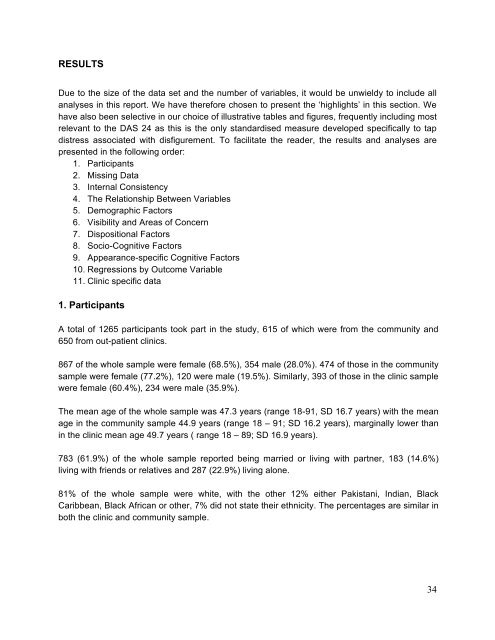Download the report - The Healing Foundation
Download the report - The Healing Foundation
Download the report - The Healing Foundation
You also want an ePaper? Increase the reach of your titles
YUMPU automatically turns print PDFs into web optimized ePapers that Google loves.
RESULTS<br />
Due to <strong>the</strong> size of <strong>the</strong> data set and <strong>the</strong> number of variables, it would be unwieldy to include all<br />
analyses in this <strong>report</strong>. We have <strong>the</strong>refore chosen to present <strong>the</strong> ‘highlights’ in this section. We<br />
have also been selective in our choice of illustrative tables and figures, frequently including most<br />
relevant to <strong>the</strong> DAS 24 as this is <strong>the</strong> only standardised measure developed specifically to tap<br />
distress associated with disfigurement. To facilitate <strong>the</strong> reader, <strong>the</strong> results and analyses are<br />
presented in <strong>the</strong> following order:<br />
1. Participants<br />
2. Missing Data<br />
3. Internal Consistency<br />
4. <strong>The</strong> Relationship Between Variables<br />
5. Demographic Factors<br />
6. Visibility and Areas of Concern<br />
7. Dispositional Factors<br />
8. Socio-Cognitive Factors<br />
9. Appearance-specific Cognitive Factors<br />
10. Regressions by Outcome Variable<br />
11. Clinic specific data<br />
1. Participants<br />
A total of 1265 participants took part in <strong>the</strong> study, 615 of which were from <strong>the</strong> community and<br />
650 from out-patient clinics.<br />
867 of <strong>the</strong> whole sample were female (68.5%), 354 male (28.0%). 474 of those in <strong>the</strong> community<br />
sample were female (77.2%), 120 were male (19.5%). Similarly, 393 of those in <strong>the</strong> clinic sample<br />
were female (60.4%), 234 were male (35.9%).<br />
<strong>The</strong> mean age of <strong>the</strong> whole sample was 47.3 years (range 18-91, SD 16.7 years) with <strong>the</strong> mean<br />
age in <strong>the</strong> community sample 44.9 years (range 18 – 91; SD 16.2 years), marginally lower than<br />
in <strong>the</strong> clinic mean age 49.7 years ( range 18 – 89; SD 16.9 years).<br />
783 (61.9%) of <strong>the</strong> whole sample <strong>report</strong>ed being married or living with partner, 183 (14.6%)<br />
living with friends or relatives and 287 (22.9%) living alone.<br />
81% of <strong>the</strong> whole sample were white, with <strong>the</strong> o<strong>the</strong>r 12% ei<strong>the</strong>r Pakistani, Indian, Black<br />
Caribbean, Black African or o<strong>the</strong>r, 7% did not state <strong>the</strong>ir ethnicity. <strong>The</strong> percentages are similar in<br />
both <strong>the</strong> clinic and community sample.<br />
34


